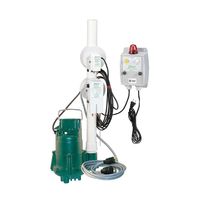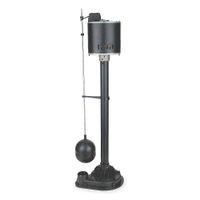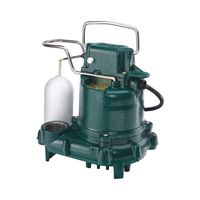Call +(254) 703 030 000 / 751 483 999 / 721 704 777
- Home
- Pumps
- Sump Sewage Utility Pumps
- Sump Pumps
- Primary Sump Pumps
Primary Sump Pumps
Primary sump pumps drain water from sump pits to prevent water damage to buildings and belongings. They are the main operating pump while back-up pumps are only used if the primary pump fails. Submersible sump pumps install at the bottom of sump pits with the motor and pump submerged in the water. P .....Read More
Frequently Asked Questions
What is a primary sump pump and how does it work?
A primary sump pump is a device used to remove accumulated water from a sump basin, typically found in the basement of homes. Its main function is to prevent flooding and manage water intrusion, especially in areas prone to heavy rainfall or with high water tables.
The sump pump system consists of a sump pit, a pump, and a discharge pipe. The sump pit is a hole dug at the lowest point of the basement, where water naturally collects. The pump is placed inside this pit and is equipped with a float switch that activates the pump when the water reaches a certain level.
When the water level in the sump pit rises, the float switch triggers the pump to turn on. The pump then draws water from the pit and pushes it through the discharge pipe, which directs the water away from the house to a designated drainage area, such as a storm sewer or a dry well. This prevents the water from overflowing the pit and flooding the basement.
Primary sump pumps are typically powered by electricity and come in two main types: submersible and pedestal. Submersible pumps are installed inside the sump pit and are designed to operate underwater, while pedestal pumps have the motor mounted above the pit, making them easier to service.
Regular maintenance, such as cleaning the pump and checking the float switch, is essential to ensure the sump pump operates effectively. In areas with frequent power outages, a battery backup system is recommended to keep the pump functioning during electrical failures.
How do I choose the right size sump pump for my home?
1. **Assess Water Volume**: Determine the amount of water your sump pump needs to handle. Consider factors like basement size, water table level, and local rainfall.
2. **Pump Capacity**: Choose a pump with a capacity that matches your needs. Capacity is measured in gallons per hour (GPH) or gallons per minute (GPM). A typical home may require a pump with a capacity of 2,500 to 3,000 GPH.
3. **Head Pressure**: Calculate the vertical distance from the sump pit to the discharge point. This is the "head" and affects pump performance. Ensure the pump can handle the required head pressure.
4. **Pump Type**: Decide between submersible and pedestal pumps. Submersible pumps are quieter and more efficient, while pedestal pumps are easier to maintain.
5. **Power Source**: Consider a pump with a battery backup or water-powered backup to ensure operation during power outages.
6. **Pump Material**: Choose durable materials like cast iron or stainless steel for longevity, especially if the pump will be used frequently.
7. **Switch Type**: Opt for a reliable switch mechanism, such as a vertical float switch, to ensure the pump activates when needed.
8. **Discharge Size**: Ensure the pump's discharge pipe size matches your plumbing to prevent bottlenecks.
9. **Warranty and Brand**: Select a reputable brand with a good warranty for reliability and support.
10. **Professional Consultation**: If unsure, consult a professional to assess your specific needs and recommend the right pump size.
What is the difference between a submersible and a pedestal sump pump?
A submersible sump pump and a pedestal sump pump are both used to remove water from basements or crawl spaces, but they differ in design, installation, and operation.
A submersible sump pump is designed to operate underwater. It is installed inside the sump pit, submerged in water. This type of pump is typically more powerful and efficient, as it is directly in contact with the water it needs to pump out. The submersible design also tends to be quieter since the motor is underwater, which muffles the noise. Additionally, submersible pumps are less prone to overheating because the surrounding water helps cool the motor. However, they can be more expensive and may require more effort to service or replace due to their location inside the pit.
In contrast, a pedestal sump pump has its motor mounted above the sump pit, with only the pump itself located inside the pit. This design makes the motor easily accessible for maintenance and repairs. Pedestal pumps are generally less expensive and have a longer lifespan because the motor is not exposed to water. However, they are typically noisier due to the motor being above the pit and not submerged. Pedestal pumps are also less powerful compared to submersible pumps, making them more suitable for smaller volumes of water or less frequent use.
In summary, the choice between a submersible and a pedestal sump pump depends on factors like budget, noise tolerance, maintenance preferences, and the volume of water to be managed. Submersible pumps offer efficiency and quiet operation, while pedestal pumps provide easier access and cost-effectiveness.
How often should a primary sump pump be replaced?
A primary sump pump should typically be replaced every 7 to 10 years. However, this timeframe can vary based on several factors, including the quality of the pump, frequency of use, and maintenance practices. High-quality pumps may last longer, while cheaper models might need replacement sooner. If the pump is used frequently, such as in areas with high water tables or frequent heavy rainfall, it may wear out faster and require replacement closer to the 7-year mark. Regular maintenance, such as cleaning the pump and checking for debris, can extend its lifespan. Additionally, if the pump shows signs of failure, such as unusual noises, frequent cycling, or reduced efficiency, it may need to be replaced sooner.
What maintenance is required for a primary sump pump?
1. **Regular Inspection**: Check the sump pump every 3-4 months to ensure it is functioning properly. Look for any signs of wear or damage.
2. **Clean the Pump and Pit**: Remove any debris, dirt, or sediment from the sump pit and pump. This should be done at least once a year to prevent clogs and ensure efficient operation.
3. **Test the Pump**: Pour a bucket of water into the sump pit to ensure the pump activates and drains the water properly. This should be done every few months.
4. **Check the Float Switch**: Ensure the float switch moves freely and is not obstructed. The float switch activates the pump when water levels rise.
5. **Inspect the Discharge Pipe**: Ensure the discharge pipe is clear and free of obstructions. Check for any leaks or damage and ensure it directs water away from the foundation.
6. **Examine the Check Valve**: Ensure the check valve is functioning properly to prevent water from flowing back into the sump pit.
7. **Lubricate Moving Parts**: If applicable, lubricate any moving parts to reduce friction and wear.
8. **Test the Backup Power Source**: If the sump pump has a battery backup, test the battery regularly to ensure it is charged and functioning. Replace the battery every 2-3 years or as needed.
9. **Listen for Unusual Noises**: Pay attention to any unusual noises during operation, which could indicate a problem with the motor or impeller.
10. **Professional Inspection**: Consider having a professional inspect the sump pump annually to ensure all components are in good working order.
11. **Replace the Pump as Needed**: Sump pumps typically last about 7-10 years. Replace the pump if it shows signs of significant wear or failure.
How do I test if my sump pump is working properly?
1. **Visual Inspection**: Check the sump pump for any visible signs of damage or wear. Ensure the power cord is in good condition and the pump is plugged in properly.
2. **Check the Power Source**: Make sure the pump is connected to a working power outlet. Test the outlet with another device to confirm it’s functioning.
3. **Inspect the Discharge Pipe**: Ensure the discharge pipe is not blocked or frozen and is directing water away from your home’s foundation.
4. **Test the Float Switch**: Pour water into the sump pit slowly until the float rises. The pump should activate automatically. If it doesn’t, the float switch may be stuck or faulty.
5. **Listen for Unusual Noises**: When the pump is running, listen for any strange noises like grinding or rattling, which could indicate a problem.
6. **Check the Pump’s Performance**: Observe how quickly the pump removes water from the pit. It should activate and clear the water efficiently.
7. **Inspect the Check Valve**: Ensure the check valve is installed correctly and functioning to prevent water from flowing back into the pit.
8. **Test the Backup System**: If you have a battery backup or secondary pump, test it to ensure it activates when the main pump fails or during a power outage.
9. **Regular Maintenance**: Clean the sump pit and pump inlet screen regularly to prevent debris buildup.
10. **Professional Inspection**: Consider having a professional inspect the pump annually to ensure it’s in optimal working condition.
What are common reasons for a sump pump failure?
Common reasons for sump pump failure include:
1. **Power Failure**: Sump pumps rely on electricity, and during storms, power outages can render them inoperative. A backup power source, like a battery or generator, is essential.
2. **Switch Problems**: The float switch, which activates the pump, can become stuck or tangled, preventing the pump from turning on or off. This is often due to debris or improper installation.
3. **Clogged Discharge Lines**: The discharge line can become clogged with debris, ice, or sediment, preventing water from being expelled. This can cause the pump to overheat or fail.
4. **Improper Installation**: Incorrect installation can lead to operational issues. This includes improper sizing, incorrect positioning, or inadequate sealing, which can cause the pump to work inefficiently or fail.
5. **Lack of Maintenance**: Regular maintenance is crucial. Without it, components can wear out, debris can accumulate, and the pump can become less effective over time.
6. **Old Age**: Sump pumps have a limited lifespan, typically around 7-10 years. As they age, their efficiency decreases, and the likelihood of failure increases.
7. **Overwhelmed Pump**: A pump that is too small for the volume of water it needs to handle can become overwhelmed, leading to failure. This is common during heavy rainfalls or flooding.
8. **Frozen or Clogged Intake**: The intake can freeze or become clogged with debris, preventing water from entering the pump, which can cause it to overheat and fail.
9. **Defective Product**: Manufacturing defects can lead to premature failure. It's important to choose a reliable brand and model.
10. **Check Valve Failure**: A faulty check valve can cause water to flow back into the sump pit, forcing the pump to work harder and potentially leading to burnout.


